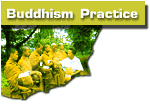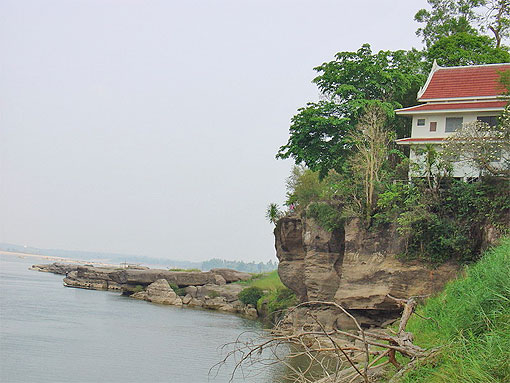 |
BANGKOK
|
||||||||
CENTRAL
|
||||||||||||
NORTHEASTERN
|
||||||||||||||
NORTHERN
|
||||||||||||
SOUTHERN
|
||||
 |
| A GUIDE TO MEDITATION CENTRES IN THAILAND |
| NORTHEASTERN - WAT HIN MAAK PENG |
|
MEANING
OF NAME : |
"It refers to 3 large rocks beside the river shaped like measuring weights once used in Thailand. |
ADDRESS : |
Tambol Pra Putabat, Amper Si Chiangmai, Nong Khai 43130 |
DIRECTIONS : |
Located on the banks of the Maekhong River, 655 km northeast of Bangkok. The temple is 68 km west of Nong Khai, the provincial capital. The town of Si Chiangmai, 18 km east of the wat, has bus connections with Nong Khai, Udon Thani, Khon Kaen, Nakhon Ratchasima, and Bangkok. The overnight tour bus from Bangkok run by Baramee Tour goes all the way to the wat if there are 8 or more passengers headed there. You can also take rains to Nong Khai or fly to Udon Thani (91 km from the wat). Songtaews go to Wat Hin Maak Peng from Si Chiangmai; other songtaews and local buses can drop you off at the gate, then it's half a kilometer walk in. |
TELEPHONE : |
0-4245-1110 |
MEDITATION
SYSTEM : |
Anapanasati (mindfulness with breathing), mental repetition of "Buddho," or maranasati (recollection of death) is used to develop concentration along with mindfulness. One then uses this "mind strength" to investigate the body and know its true characteristics. From this knowledge, the mind becomes free from clinging. |
TEACHING
METHOD : |
Everyone
is free to follow their own meditation system. Instruction is available
mainly through books and tapes. Luang Poo Tate and other senior monks will answer questions. Mindfulness and observance of disciplinary code and temple rules are important in practice. |
TEACHERS : |
Luang Poo Tate, abbot (Thai; age 89) |
LANGUAGE : |
The
vice abbot, Ajahn Pichit, and a few other monks speak English; they
can translate and answer questions. Luang Poo Tate meets with visitors and answers their questions in Thai. He no longer gives talks, but his books (in Thai and English) and recordings of Dhamma talks (Thai) are available. The Autobiography of a Forest Monk, by Venerable Ajahn Tate, recently became available in an English version, edited by Bhikkhu Ariyesako. Luang Poo Tate conveys much wisdom to the reader through stories and lessons from his life. The 314-page book is in libraries and available for free distribution from the monastery. |
DESCRIPTION : |
Many large, attractive buildings perched on the banks of the Maekhong River, opposite Laos. Scenic and quiet location with trees and bamboo groves. On entering the wat, you'll come to guest houses for laypeople on the right, the bot (uposatha hall) on the right, the abbot's residence on the right, then the main sala on the left. Monks and novices stay in kutis beyond the main sala. Ask one of monks in the main sala if you would like to stay if you have questions. |
SIZE : |
monks
35-50 novices 5-12 nuns 6-20 laypeople 15-30 |
DAILY
ROUTINE : |
A typical daily schedule begins with a bell at 3 a.m. for individual meditation practice (optional); 630 a.m. monks and novices go on pindabat; 730 a.m. monks and novices chant (usually in uposatha hall); 8 a.m. meal for monks, novices, and pakows in main sala (laypeople sit opposite and chant); 9 a.m. laypeople eat; 3 p.m. work period (sweeping and other chores); 4 p.m. drink; 430 p.m. work period (cleaning main buildings); 7 p.m. chanting in main sala; 8-10 p.m.meditation in uposatha hall. |
FOOD : |
Very good Bangkok-style. Monks and novices go on pindabat for rice; most food comes from the kitchen and donors. Laypeople eat leftovers after monks finish eating. (It's allowable for foreigners to set aside some leftovers before the chanting, as the Thai laypeople quickly scoop up everything in sight as soon as the chanting ends.) |
ACCOMMODATIONS : |
Monks and novices have individual kutis, somewhat close together. Laypeople who come for meditation can stay in guest houses (shared rooms), separate buildings for men and women. Laymen can also ask for a kuti in the monks' area. Most kutis have screens, electricity, and attached bathrooms. Bathrooms have showers or tanks for bathing and Asian-style toilets. |
WRITE
IN ADVANCE? : |
Recommended. Write with your plans to stay and whether or not you speak Thai. |
OTHER
INFORMATION : |
Luang Poo Tate practiced under the famous Ajahn Mun for 9 years. He
later founded this monastery on a site that had been popular with
monks on tudong. Almost all monks here spend time on tudong. Some malaria exists, so one needs to be careful to use repellent or netting from dusk to dawn. Visiting monks and novices who plan to spend more than 14 days need a letter of permission from their monastery. Laypeople should observe 8 precepts, respect rules, be self-reliant and motivated, and be quiet (socializing is discouraged). Women stay in their area except for some group chantings, meeting with a teacher, making offerings ( dana ), or paying respect to monks. Women should speak at least a little Thai. |
| Select here : |
|
|
